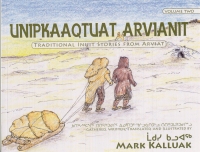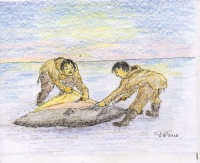| ________________
CM . . .
. Volume XIX Number 27. . . .March 15, 2013 
 |
Unipkaaqtuat Arvianit = Traditional Inuit Stories From Arviat. Volume Two.
Mark Kalluak.
Iqaluit, Nunavut: Inhabit Media, 2010.
143 pp., pbk., $29.95.
ISBN 978-1-926569-178.
Subject Headings:
Inuit-Nunavut-Arviat-Folklore.
Inuit mythology-Nunavut-Arviat.
Oral tradition-Nunavut-Arviat.
Grades 4-7 / Ages 9-12.
Review by Gail de Vos.
*** /4
|
| |
|

excerpt:
I am going to tell a story based on a traditional Inuit belief about the moon. Everything we see around us that exists today has its own beginning. I heard a story about something that happened a long time ago that explains what we can see on the moon today. The story is told like this:
A very long time ago, people lived differently than they do today. Inuit lived in iglus and they often chiselled holes through the ices of nearby lakes to fetch water. People would then fill skin buckets with water from the holes. One night, during those long ago times, a woman decided to go fetch water under the bright light of a full moon. She carried a caribou skin bucket in her hand... So at night, when you look up at a bright full moon, you may see an outline of this woman standing with a bucket in her hand. She was pulled up to the moon for gazing at it for too long. This was something we were warned about as children—never gaze at the moon for too long because there are consequences.
This second volume of Inuit folktales, presented in both Inukitat syllabics and English, consists of 11 stories collected, translated and illustrated by the respected community elder and storyteller Mark Kalluak. The stories include pourquoi tales, such as how the sun and the moon came into existence and the creation of mosquitoes, tales of mythical and paranormal characters, and traditional teaching stories. Peppered with Inukitat terms, translated naturally within the storyline, the stories seamlessly move off the page to replicate an oral storytelling session. The stories provide a glimpse into the knowledge base of traditional Inuit culture and belief systems as well as the interaction between Inuit and wildlife. The tales often include instances of violence, authentically reflecting survival techniques in an inhospitable environment. the respected community elder and storyteller Mark Kalluak. The stories include pourquoi tales, such as how the sun and the moon came into existence and the creation of mosquitoes, tales of mythical and paranormal characters, and traditional teaching stories. Peppered with Inukitat terms, translated naturally within the storyline, the stories seamlessly move off the page to replicate an oral storytelling session. The stories provide a glimpse into the knowledge base of traditional Inuit culture and belief systems as well as the interaction between Inuit and wildlife. The tales often include instances of violence, authentically reflecting survival techniques in an inhospitable environment.
In many instances, the introduction to individual stories provides source notes for Kalluak’s acquisition of the tales. He repeatedly reminds the reader that “there are many variations of this story because many communities have their own unique version.” He then identifies the community in which this particular story is told. The illustrations are childlike, coloured in warm pastel shades, and evocative of the landscape.
Recommended.
Gail de Vos teaches at the School of Library and Information Studies for the University of Alberta and is the author of nine books on storytelling and folklore.

To comment
on this title or this review, send mail to cm@umanitoba.ca.
Copyright © the Manitoba Library Association. Reproduction for personal
use is permitted only if this copyright notice is maintained. Any
other reproduction is prohibited without permission.
NEXT REVIEW |
TABLE OF CONTENTS FOR THIS ISSUE
- March 15, 2013.
AUTHORS |
TITLES |
MEDIA REVIEWS |
PROFILES |
BACK ISSUES |
SEARCH |
CMARCHIVE |
HOME |

 the respected community elder and storyteller Mark Kalluak. The stories include pourquoi tales, such as how the sun and the moon came into existence and the creation of mosquitoes, tales of mythical and paranormal characters, and traditional teaching stories. Peppered with Inukitat terms, translated naturally within the storyline, the stories seamlessly move off the page to replicate an oral storytelling session. The stories provide a glimpse into the knowledge base of traditional Inuit culture and belief systems as well as the interaction between Inuit and wildlife. The tales often include instances of violence, authentically reflecting survival techniques in an inhospitable environment.
the respected community elder and storyteller Mark Kalluak. The stories include pourquoi tales, such as how the sun and the moon came into existence and the creation of mosquitoes, tales of mythical and paranormal characters, and traditional teaching stories. Peppered with Inukitat terms, translated naturally within the storyline, the stories seamlessly move off the page to replicate an oral storytelling session. The stories provide a glimpse into the knowledge base of traditional Inuit culture and belief systems as well as the interaction between Inuit and wildlife. The tales often include instances of violence, authentically reflecting survival techniques in an inhospitable environment.